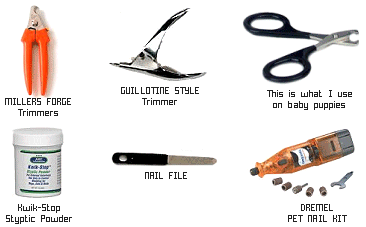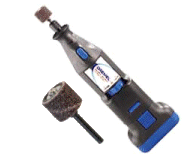|
 TOOLS FOR CLIPPING NAILS
TOOLS FOR CLIPPING NAILS |
|
|

Some
of the tools I use for nail trimming on my Löwchen & Cresteds
|
| |
|
Nails are frequently broken. This is mostly the result of not keeping the nails short. If a dog does not walk on a hard surface regularly, the nails may not wear down enough, and they should be clipped on a regular base. The most commonly affected nails are those on the dew claws (or ‘thumbs’) of a dog, as these nails do not touch the ground when walking. Broken nails are painful and will often lead to licking and gnawing at the affected toe or paw. It can also lead to local infections, which may show as redness and swelling. Your vet can treat broken nails if necessary and clip the nails on a regular base to prevent nails breaking. You can also learn how to clip your dog’s nails yourself.
Brittle nails can be the result of fungal infections, certain types of mange, nutritional disorders and some auto-immune disorders. If your dog regularly breaks nails without any obvious reason or the nails being too long, it is advisable to have your dog examined by your vet. He or she may want to do several tests, like for instance blood tests, to find out if there is an underlying disease. |
| |
 TIPS
TIPS |
| |
|
|
-
Clip the nails after a bath when they are soft.
-
For long-haired dogs, slip an old pair of
panty-hose over the paw, and push the nails through the stocking.
This will safely hold the hair away from the nail clippers or Dremel and eliminate any possibility of accidentally cutting the
precious bracelet hair, or worse, getting the hair caught in the
spinning Dremel!
-
Break open a Vitamin E capsule and rub the oil
into the pads to keep them nice and soft.
-
Rub a little Vaseline into the nails after
clipping/filing and polish them with a soft cloth. Now they look
brand new!
-
Instead of the Dremel, I use a mini Hobby
Engraver by Medalist that I bought at Mitre 10 for $19.95. It came
complete with about 30 drills, buffs, etc.
|
| |
 NAIL TRIMMING PROCEDURE
NAIL TRIMMING PROCEDURE |
| |
 Dog toenails grow as do human fingernails and toenails. The nails should be kept in good trim to avoid scratching when the dog paws at a bare human leg and to keep the dog's structure as sound as possible. Long nails can cause the dog to rock back on his paws, causing strain on his leg assemblies and interfering with his gait. Dog toenails grow as do human fingernails and toenails. The nails should be kept in good trim to avoid scratching when the dog paws at a bare human leg and to keep the dog's structure as sound as possible. Long nails can cause the dog to rock back on his paws, causing strain on his leg assemblies and interfering with his gait.
The easiest way is to accustom puppies to having their feet handled daily so they'll sit still for this essential part of good grooming. Adult dogs may be more difficult, especially if they hate having their feet handled or have been
"quicked" at some time.
Sometimes, dog nails grind down if the dog exercises on concrete. Otherwise, the nails should be trimmed regularly.
Regular nail trimming is important to your dog's health and well being. Never use ordinary scissors to trim your dog's nails. Use trimmers that are specially designed for dogs. Hold the dog's paw firmly, and cut off the tip of the nail with a single stroke. Be very careful to stop short of the quick, the blood vessel inside the nail. Cutting the nails right after bathing will make the quick more visible; applying baby oil will serve the same purpose. Follow up by filing your dog's nails with a nail file. Ask your vet to show you the correct technique the first time, especially if your dog has dark nails.
Dog nails have a blood supply or quick but the end of the nails are dead tissue and can be clipped without pain. The trick is to trim as close to the quick as possible without actually cutting it and causing it to bleed. The quick appears as a dark line in white nails but is almost impossible to see in darn nails. The best way to begin trimming is to clip only the sharp, curved portion of the nail and then work back a bit towards the paw. Clip only a small bit at a time to avoid trouble.
No matter how careful you are, you can accidentally hit a nail quick and cause some bleeding at some point. Don't panic. Here are some things that will stop the bleeding:
-
Kwik-Stop (a powder) or any styptic powder.
This stings, but is highly effective. Take a pinch of powder and press onto the tip of the affected nail after wiping away the blood.
-
cornstarch or flour can also be used in a similar manner
-
you can press the affected nail into a bar of mild soap
-
for minor problems, simply applying pressure to the tip of the nail may be effective
Some dogs have black nails. To tell how to cut these, turn your dog's paw over and look where the nail has a thicker section than the growth area. Use this as a guideline when trying to figure out where to cut the nail. They won't give the appearance of clearer at the top of the nail, so you have to be very careful that you go by the thickness of the nail when the paw is turned over. Any part of the nail that is thick is the "Quick" in this case and should not be cut. This is the part of the nail on the bottom that grows from his paw. The skinnier part of the nail is the new growth, that you can cut without fear of cutting your dog.
You can also try using a torch (flashlight) which sometimes shows
where the quick is located.
Some dogs do not like having their nails clipped. Take some wooden matchsticks, and cut the matchsticks to get your dog used to the sound, giving her a treat with each cut. Handle your dog’s feet several times a day, giving her a scrumptious treat as you touch them. Then take the nail clipper out and put it on the floor near your dog. Give her a treat every time she looks at the clipper. Pick it up and slowly bring it closer to her giving her treats the whole time.
Hold your dog‘s foot and put the matchstick underneath her foot and cut the matchstick. When she gets used to this, then put the clipper to her nails and pretend to cut them. |
|
| |
| FOOT
INJURIES |
|
|
|
Athletes must take good care of their feet in order to continue their “work” or sport. Canine athletes are no exception. A major difference between humans and canines (besides the two legs or four legs) is that dogs seldom wear protective foot covering.
Pododermatitis is a word that means inflammation of the skin of the paw. Hunting dogs are often hunted over rough terrain. They may step on thorns, sharp rocks, or other plant particles that are irritating. Because of the trauma to the foot, it is susceptible to inflammation. Hunting hard and then being returned to a gravel pen may exacerbate the inflammation. Racing greyhounds may suffer from pododermatitis secondary to the sand surfaces that they race on. Treating the pododermatitis usually involves rest, cleaning and debriding the paw, and possibly systemic medications like antibiotics or anti-inflammatories.
Injuries to the nails are extremely painful and also quite common. Keeping the nails too short leave them susceptible to exposure of the sensitive quick. If the nails are kept too long, one may be caught and damaged during intense exercise. Nails can be fractured and usually must be removed to allow the
nail bed to heal and a new nail to grow in. When a nail or nail bed is damaged, it is much more susceptible to becoming infected. Bacteria or even fungi can invade the damaged tissue and wreak havoc. Fungal infections are more common in hunting dogs because of exposure to fungal organisms in the soil, especially in wooded or warm, damp climates.
Finally, footpad injuries are also quite common across the board for sporting dogs. Rough terrain, chemical disinfectants or materials such as ice melt, and even autoimmune diseases can affect the pads. In sled racing dogs, a condition of zinc deficiency can result in crusty lesions of the face and footpads. These dogs do not absorb zinc from their gastrointestinal tract, so intravenous zinc preparations must be used to correct the deficiency. Lacerations of the pads are the most common injury to this part of the body. Surgical closure of the wound is possible, but bandaging and strict rest will also be required to allow the pad to heal.
Careful examination of the feet following any work will help prevent small problems from becoming big problems that sideline the athlete. Clean and dry housing will also help prevent these problems from occurring.
By Dr. Brookshire
Director of Veterinary Services
* If a paw or other area of the body is cut or torn, you will need to clean the wound and to stop the bleeding. Clean with a light salt solution (a heaping tablespoon in a gallon of water), then use antibiotic cream. Cover with gauze and wrap with a stretch bandage to yield just enough pressure to stop the bleeding. Do not over-tighten, as that may stop circulation and cause further problems.
CHECK OUT
NAIL & PAW CONDITIONS HERE |
|
 LINKS TO NAIL CLIPPING & RELATED ARTICLES
LINKS TO NAIL CLIPPING & RELATED ARTICLES |
|
|
|
|
|
Using Dremel or Oster Grinders on Nails |
| Nail Conditions | Trimming Tools |
Nail Trimming Procedure |
Nail Clipping Article Links |
|
Paw Conditions |
Nail & Paw Conditions Links |

| Grooming
| Breed
Specific Grooming | Mars
Coat King Guide |
| Clipper Care
| List of
Blades | Breeds
Blades Chart | Using
Clipper Combs |
| Top Knots |
Wrapping Coats |
Tear Stains |
Growing Coat |
Pet/Puppy Clips |
| Ears
| Eyes
| Canine
Skin | Handy
Hints | Pre-Conditioning
Oil Recipe |
| Nail
Conditions | Trimming
Nails & The Canine Paw | Grooming
Tools I Use |
| Groomed For Success
| Australian Dog Show Equipment |

|
|

 Dog toenails grow as do human fingernails and toenails. The nails should be kept in good trim to avoid scratching when the dog paws at a bare human leg and to keep the dog's structure as sound as possible. Long nails can cause the dog to rock back on his paws, causing strain on his leg assemblies and interfering with his gait.
Dog toenails grow as do human fingernails and toenails. The nails should be kept in good trim to avoid scratching when the dog paws at a bare human leg and to keep the dog's structure as sound as possible. Long nails can cause the dog to rock back on his paws, causing strain on his leg assemblies and interfering with his gait.